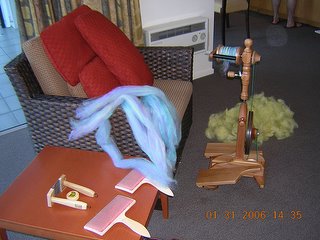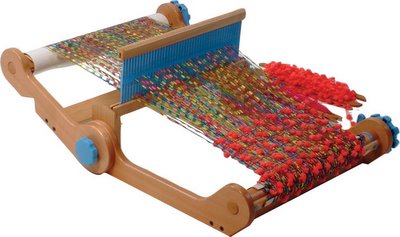 Thirty-six hours since leaving Cabin John, we are finally in Blue Peaks Apts. First things first: set up that Little Gem.
Thirty-six hours since leaving Cabin John, we are finally in Blue Peaks Apts. First things first: set up that Little Gem.
Tuesday, January 31, 2006
Arrival in Queenstown
 Thirty-six hours since leaving Cabin John, we are finally in Blue Peaks Apts. First things first: set up that Little Gem.
Thirty-six hours since leaving Cabin John, we are finally in Blue Peaks Apts. First things first: set up that Little Gem.
Sunday, January 29, 2006
Saturday, January 28, 2006
Impromptu Spinning Classes
Learned to spin ingeo, bamboo, and soy silk with Sylvia. This is the class I will miss in February due to travel. Later joined two others to learn about spinning cotton.
Tuesday, January 24, 2006
Fiber Study @ Springwater Fiber
First of the three-class course with Sylvia Del Mar. Tonight was devoted to spinning camel, llama and alpaca fibers.
Thursday, January 19, 2006
My 15 minutes of fame @ The New York Times
Thursday Styles section
January 19, 2006
The New Spinners: Yarn Is the Least of It (Excerpt)
By ELIZABETH OLSON
THERESE CRUZ is a newcomer to the ancient art of spinning, and she is hooked. She began learning to spin last June, already has two imported wooden spinning wheels and is getting ready to buy an even nicer one.
"It saves me from being addicted to anything else," Ms. Cruz, said with a laugh as she pressed her bare feet, one after the other, against wooden pedals and steadily fed puffs of colorful fleece into her turning wheel.
She and a dozen other avid spinners had gathered at a fiber workshop in Alexandria, Va., in early January to celebrate St. Distaff's Day, the ancient English holiday when household chores resumed after the 12 days of Christmas. The spinners had come with their own wheels, from large wooden machines to small Indian charkhas, and were diligently producing yarn thick and thin, colorful and plain, wool and silk.
"It is like taking a trip," Ms. Cruz said. "It is so tranquilizing to do this at the end of a day."
Randy Scheessele, who sat beside Ms. Cruz at the gathering, held at the Springwater Fiber Workshop, was making yarn on a drop spindle, an early spinning method that relies on a dowel topped by a hook, a piece of wood or even a CD. "When you come home after a day's work," said Mr. Scheessele, an economist at the Department of Housing and Urban Development, "spinning helps you wind down."
Spinning's under-the-radar growth can be found in the details. For example Ms. Cruz, a senior program assistant at the World Bank who lives in Cabin John, Md., said she had to check Web sites vigilantly last year to find an opening in a beginner's class.
She was introduced to spinning last year at the Maryland Sheep and Wool Festival, a sprawling two-day gathering each May that draws 60,000 people to watch sheep-shearing and herding, to buy bags of fleece and yarn and to choose among hundreds of spinning wheels of every shape, size and price.
"I knew right away I had to learn," Ms. Cruz recalled.
January 19, 2006
The New Spinners: Yarn Is the Least of It (Excerpt)
By ELIZABETH OLSON
THERESE CRUZ is a newcomer to the ancient art of spinning, and she is hooked. She began learning to spin last June, already has two imported wooden spinning wheels and is getting ready to buy an even nicer one.
"It saves me from being addicted to anything else," Ms. Cruz, said with a laugh as she pressed her bare feet, one after the other, against wooden pedals and steadily fed puffs of colorful fleece into her turning wheel.
She and a dozen other avid spinners had gathered at a fiber workshop in Alexandria, Va., in early January to celebrate St. Distaff's Day, the ancient English holiday when household chores resumed after the 12 days of Christmas. The spinners had come with their own wheels, from large wooden machines to small Indian charkhas, and were diligently producing yarn thick and thin, colorful and plain, wool and silk.
"It is like taking a trip," Ms. Cruz said. "It is so tranquilizing to do this at the end of a day."
Randy Scheessele, who sat beside Ms. Cruz at the gathering, held at the Springwater Fiber Workshop, was making yarn on a drop spindle, an early spinning method that relies on a dowel topped by a hook, a piece of wood or even a CD. "When you come home after a day's work," said Mr. Scheessele, an economist at the Department of Housing and Urban Development, "spinning helps you wind down."
Spinning's under-the-radar growth can be found in the details. For example Ms. Cruz, a senior program assistant at the World Bank who lives in Cabin John, Md., said she had to check Web sites vigilantly last year to find an opening in a beginner's class.
She was introduced to spinning last year at the Maryland Sheep and Wool Festival, a sprawling two-day gathering each May that draws 60,000 people to watch sheep-shearing and herding, to buy bags of fleece and yarn and to choose among hundreds of spinning wheels of every shape, size and price.
"I knew right away I had to learn," Ms. Cruz recalled.
Monday, January 16, 2006
Dye Day @ Springwater Fiber Workshop
I've volunteered to dye with Sylvia from 10 am to 4 pm. Products will be sold at the Maryland Sheep and Wool Festival on May 7 and 8.
Monday, January 02, 2006
St. Distaff Day @ Fluff and Nonsense
We had an exchange gift in honor of St. Distaff Day at the Fluff and Nonsense meet this evening. Read about St. Distaff Day here. I gave away a Strauch flicker and felting batt and I received goat milk soaps. Sylvie del Mar gave each of us a ceramic sheep.
By the way, a writer from New York Times came by to interview members on the resurgence of spinning.
By the way, a writer from New York Times came by to interview members on the resurgence of spinning.
Sunday, January 01, 2006
A loom for knitters?
Subscribe to:
Comments (Atom)
